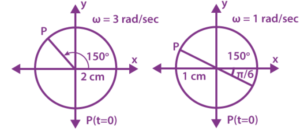(a) ![]()
![]()
![]()
On comparing the above equation with the standard equation, ![]() ,
,
Amplitude will be ![]() (radius of the circle)
(radius of the circle)
Angular velocity will be ![]()
Phase angle will be ![]()
(b) ![]()
![]()
On Comparing this equation with ![]() , we get,
, we get,
Phase angle as ![]()
Amplitude as ![]() (radius of the circle)
(radius of the circle)
Angular velocity as ![]()

